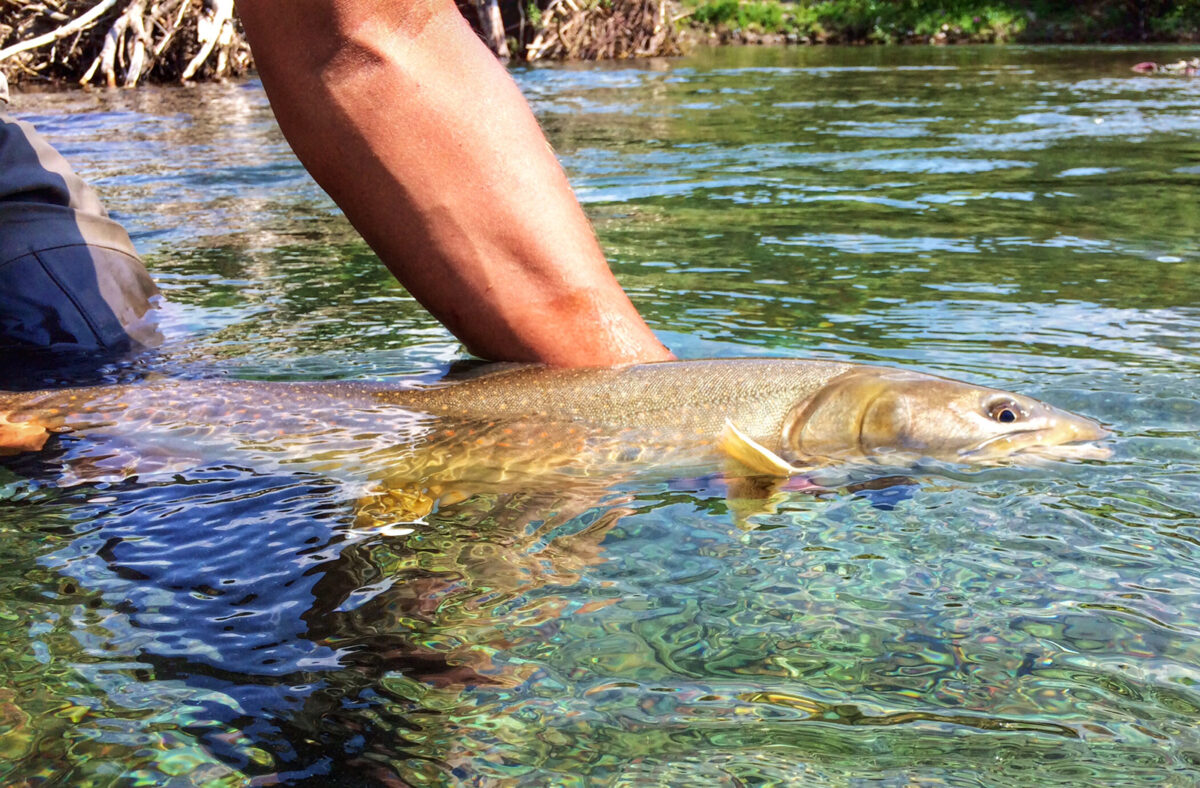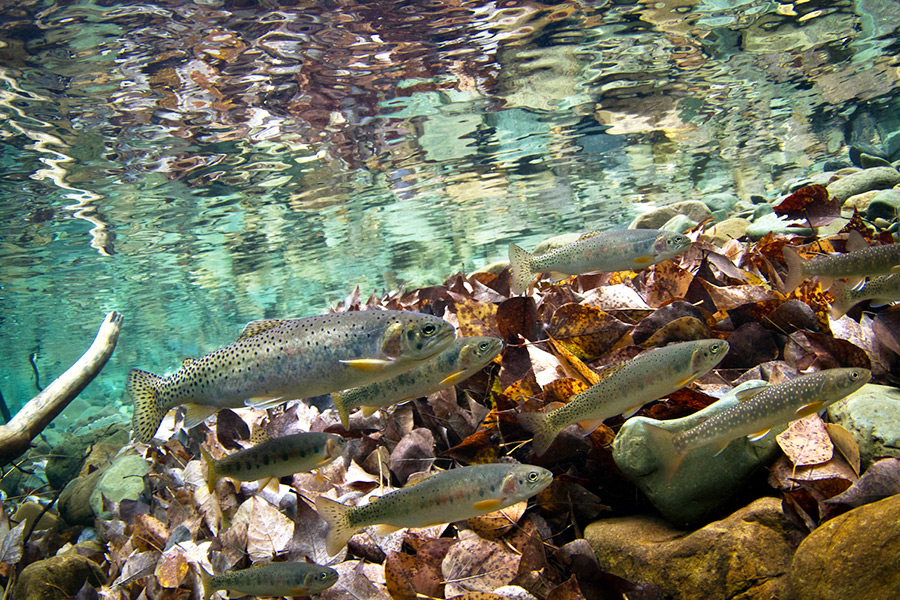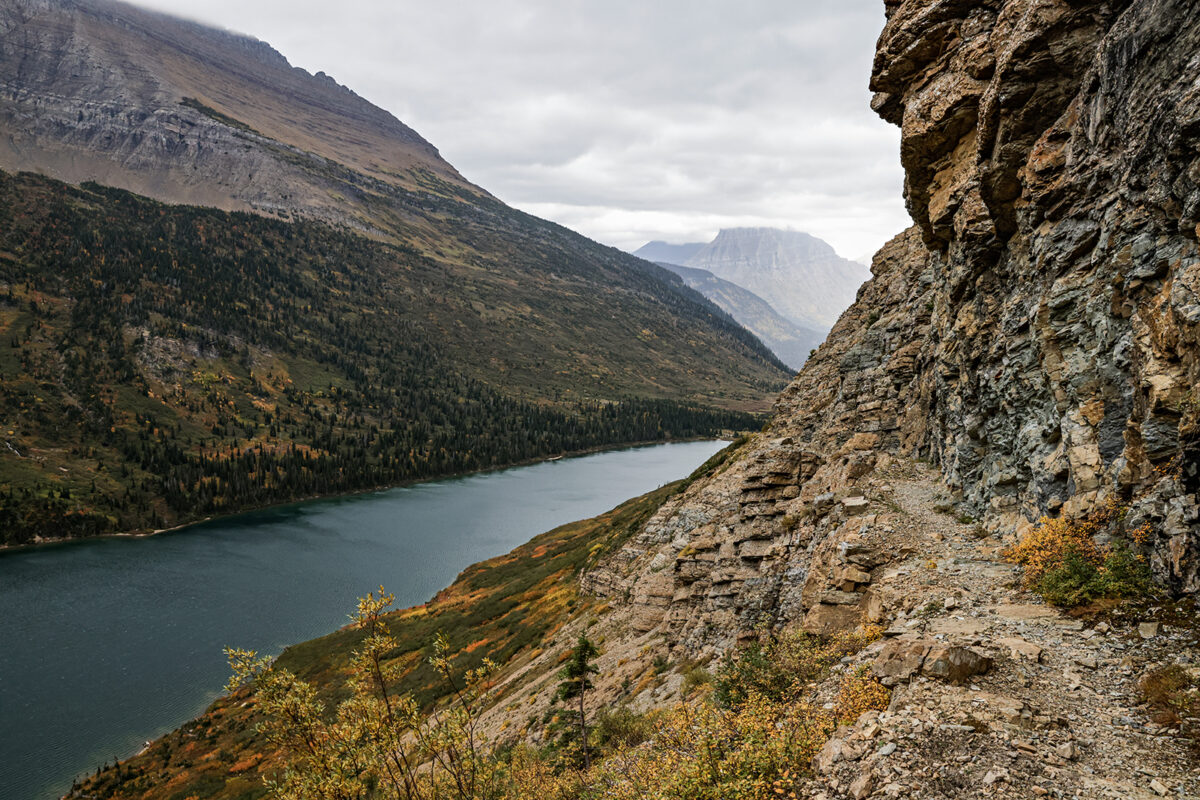Glacier Park Pauses Trout Translocation Project in Gunsight Lake Lawsuit
The remand comes after environmental organizations sued the park over its plans to transplant bull trout into an alpine lake to help preserve the native species. Glacier’s fisheries biologists could still reboot the project following additional review.
By Tristan Scott
Glacier National Park has voluntarily withdrawn plans for a multi-phase conservation strategy to replenish a remote alpine basin with genetically pure strains of westslope cutthroat trout, bull trout and mountain whitefish. The project would effectively establish a native fish preserve in Gunsight Lake, guarding against hybridization with introduced species and holding at bay the encroaching biological stress of climate pressure.
Those plans, which could still be revived, are on hold following a federal judge’s order granting voluntary remand to the National Park Service (NPS) and the U.S. Fish and Wildlife Service (FWS), the federal agencies at the center of a lawsuit alleging the Gunsight Lake fish relocation project violates both the Endangered Species Act (ESA) and the National Environmental Policy Act (NEPA). A federal judged stayed the lawsuit earlier this year to allow the parties to pursue settlement discussions. However, NPS and FWS ultimately decided voluntary remand was more appropriate because it “will allow [the agencies] to conserve their scarce … resources.”
Kate Hammond, the intermountain regional director of NPS, last week submitted the unopposed motion for voluntary remand, asking U.S. District Court Judge Dana Christensen to dismiss the lawsuit while the federal agencies reevaluate the project and conduct another biological assessment “to ensure compliance with NEPA and the ESA.”
“Having to simultaneously defend this lawsuit will divert scarce agency resources from NPS’ and FWS’ efforts to reconsider the project and meet their multiple other obligations under the ESA and NEPA,” the motion states, acknowledging “substantial and legitimate concerns” with the initial environmental review and its finding of no significant impact.
Upon completion of the additional review, park officials will determine whether to proceed with the project and issue new or revised NEPA and ESA analyses and a new decision, in coordination with FWS.
Citing the pending litigation, a spokesperson for Glacier Park declined to say whether or not officials will conduct further review and correct deficiencies in the initial assessment.
Although the park has completed the first phase of the project — exterminating the introduced population of rainbow trout living in Gunsight Lake in 2023 — it has yet to begin phase two, which entails the translocation of mountain whitefish, westslope cutthroat trout and bull trout into Gunsight Lake within Glacier National Park. The translocation of these species is the key element of the project challenged by the plaintiffs in the lawsuit.
Listed as threatened under the Endangered Species Act in 1998, bull trout populations have faced a steep decline on a landscape brimming with introduced species, which have radiated throughout the Columbia and Missouri river systems, decimating native trout species — including westslope cutthroat trout, which while not federally listed as endangered is considered a species of concern — and prompting biologists to pursue innovative new conservation strategies to conserve and protect their genetic purity.

The lawsuit filed last September in U.S. District Court in Missoula comes from Friends of the Wild Swan and the Council on Wildlife and Fish. In their complaint, the groups argue that federal agencies violated NEPA and ESA by failing to consider the consequences of collecting and propagating drainage-specific bull trout; specifically, the ecological effects associated with moving bull trout from other lakes in the St. Mary watershed, where bull trout currently live, and planting them in Gunsight Lake, where bull trout have never lived — likely because waterfalls downstream from the alpine lake serve as barriers preventing upstream fish migration.
The lawsuit also asserts that federal agencies failed to assess how a $100 million Bureau of Reclamation project to rebuild the St. Mary Diversion Dam would cumulatively affect local bull trout populations.
“Replacing that ancient, fish-killing structure will do far more to preserve threatened bull trout than creating an isolated population without any genetic exchange with other bull trout,” according to plaintiffs’ attorney Jared Pettinato.
The lawsuit’s final prong alleges NPS violated NEPA by failing to issue a supplemental environmental assessment when it “drastically changed the project” to include the introduction of mountain whitefish into Gunsight Lake.

But defenders of the project say the lawsuit is misguided and fails to account for the years of pioneering research establishing a proven framework for native fish translocations, which they say have become an important tool for the long-term conservation of threatened species. For fisheries managers who have dedicated their careers to preserving native fish in and around the park, as well as for ecologists working to support the projects through more than a decade of peer-reviewed scientific evidence, the Gunsight Lake project presents a unique opportunity to bolster bull trout populations in one of their last best strongholds.
The last drainage east of the U.S. Continental Divide to support native bull trout, the St. Mary River drainage has experienced dramatic declines of its native fish populations. Today, all but one of its remaining westslope cutthroat trout populations have some level of hybridization with either non-native rainbow or Yellowstone cutthroat trout, and researchers say that without proactive management intervention their long-term persistence hangs in the balance. A tributary of the South Saskatchewan River drainage, the St. Mary River drainage now supports hybrid species that lack the genetic and behavioral adaptations that native species have adopted over the course of millennia.
Because the genetically impure populations radiate outward from infested lakes, they have compromised the entire watershed. Gunsight Lake is an exception because it lies upstream from waterfalls and is protected from intruders, meaning fish never lived there until their introduction in the early 20th century. Those characteristics, advocates of the project say, are precisely what make Gunsight an ideal basin to reverse historic missteps in resource management, converting the alpine lake into a safe haven for native species seeking refuge from aquatic invaders and warming tributaries.

But Arlene Montgomery, with Friends of the Wild Swan, equated the conservation strategy to “playing god” and urged federal agencies to follow their own regulatory guidelines by designating the new population “experimental.”
“We are glad to see this ill-conceived project withdrawn,” Montgomery said in a prepared statement. “It was an experiment to create an isolated bull trout population without determining the true impacts to them—both in Gunsight Lake and in the streams where they were taking bull trout from.”
For native trout advocates who have been tracking their population declines, however, the long-term recovery of native fish species in northwest Montana will include a range of conservation tools, including the removal of invasive species and the translocation of native trout and their precious genetic purity.
Wade Fredenberg, the FWS’ former bull trout recovery coordinator for the region and current Flathead Valley chapter president of Trout Unlimited, said legal interferences such as this represent just “one more obstacle in the way tying our hands for the recovery of bull trout.”